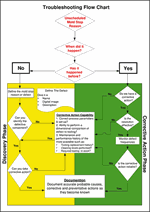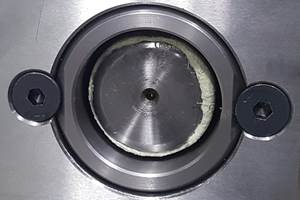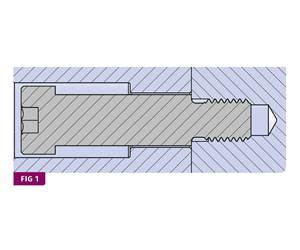What Toolroom Maintenance Supervisors Need to Know
Those in charge of keeping molds reliable and production-ready normally start their day in the same manner—wondering what broke down since they last walked out the door—and hoping they have the resources to get it going again.
Those in charge of keeping molds reliable and production-ready normally start their day in the same manner—wondering what broke down since they last walked out the door—and hoping they have the resources to get it going again. The work pace, hours, and stress level of a mold maintenance supervisor will be determined by what broke and how long it will take to get it up and running. This is what the traditional “firefighting” approach is all about. Breakdowns dictate most shop maintenance schedules, leaving too few hours to schedule preventive maintenance (PM), which allows more proactive tasks. The latter always seem to be a matter of “fitting them in”.
The last Mold Shop column (see Learn More box) discussed what type of Performance and Repair (PAR) data should be collected and used by the process technicians who set, start, and run molds. The next two columns will discuss a toolroom supervisor’s job function and what data he or she needs and how to use it to reduce breakdowns while performing his/her job more accurately and efficiently in a data-driven rather than “firefighting” environment.
FOREVER PUTTING OUT FIRES
A main factor in increasing mold performance and maintenance efficiency is our ability to quickly and accurately decipher breakdown issues. Most breakdowns are repetitive, but the specific events that surround a breakdown typically go unnoticed until it occurs again, leaving people scratching their heads and wondering, “Didn’t this just happen the other day?” and “What did we do that time?”
But once the mold is back up and running, the mental focus shifts again to the newest issue, so when a “repeat offender” mold lands on a repair technician’s bench, he or she is concerned only with today’s issues and not their potential correlation with problems from past runs.
A smaller percentage of breakdowns or unscheduled mold stops occasionally pertains to mold assembly events like the wrong tooling being installed in a mold or internal water leaks or missing tooling. As one who occasionally audits maintenance records of different companies, I see these types of mistakes occurring more often than anyone wants to admit. That is why it is important to be able to first categorize issues, then count frequencies and costs of all breakdowns, so as to accurately prioritize where your problems really lie (see chart).
The majority of unscheduled mold stops are repetitive, mechanical problems whose root causes are either hidden in ambiguous work orders or simply fade from memory once the mold is up and running again. Current “firefighting” culture directs us to focus on the problem of the day versus taking steps to reduce these unscheduled stops.
MANAGING MORE EFFICIENTLY
A maintenance supervisor needs tools to manage his department as much as the tools to work on molds. Management tools include past PAR data to troubleshoot problems, as well as a means to schedule maintenance and repair work. For accurate scheduling, a maintenance supervisor needs to know which molds will be running soon and which will need to be cleaned, repaired, changed over, or sent out for refurbishment. The status of all molds must be known at all times to allow quick reaction when a call comes in from molding or production.
To better understand what a toolroom supervisor needs to improve mold performance and maintenance efficiency, we need to further understand his/her challenges and job responsibilities. I have broken down typical job criteria into what I call the “4 R’s”: mold readiness, reliability, run, and repair.
1. Mold Readiness (or repair status): This concerns the ability of a repair shop to keep pace with pulled molds and have the required molds available (blue, green or yellow tag status) for scheduled production runs. The typical measure of performance is the ratio of active red-tag molds to the number of molds pulled weekly for cleaning, repairs or change-overs. If more molds are red-tagged than pulled in a typical production week, the shop should not be considered in a state of readiness, because the MPP (Mold Pull Pace) is greater than the BTR (Blue-Tag-Rate). MPP count should not exceed red-tag molds. In other words, if you typically pull 20 molds per week (scheduled and unscheduled combined), the red-tag total should not exceed 20.
2. Mold Reliability: (scheduled vs. unscheduled mold stops): As a starting point, unscheduled Mold Stops should not exceed 40% of all stops. I have seen this number as high as 80% in shops that have been “leaned” to the bone and staffed with inexperienced repair techs.
Repeating mold or part defects (i.e., unsuccessful attempts to correct defects) should not exceed 20% of all defects—or you need to know why:
- Do you have documented Final Check procedures and are they adhered to? This is the only way to reduce the frequency of mold stops due to mold assembly oversights (see Learn More).
- Are In-Press Servicing (during production) procedures documented and adhered to? Long-run jobs need this.
- Are PM (Preparation and Mold Setup) procedures documented and used to reduce the number of “I-forgot-to-fix-that” or “I-didn’t-know-about-it” type of mistakes (see Chart)?
3. Mold Run (performance): This is measured by the number of blocked-off cavities, cycle-time efficiency, and maintenance costs (labor and tooling) per run-time hour. A sample calculation would be to average together cycle-time efficiency and cavity efficiency to get overall production efficiency. For example, a mold running 95% cavity efficiency with a 12-sec target cycle vs. 14-sec actual (86% cycle-time efficiency) means the mold is performing at 90% overall efficiency.
Is mold cavitation within company goals (typically 94% to 98% for molds with 12 or more cavities)? Low-cavitation molds (one to four cavities) normally get repaired immediately if a cavity goes down, so cavitation goals for such molds are usually 99% to 100%.
Tooling costs and labor hours should be divided into mold production hours to determine which molds are the most expensive to run and maintain.
Are production efficiency numbers maintained within company goals? A typical goal is 0.2% to 5% scrap or rejects, but this can be a difficult number to pin down, depending upon what you track and how.
4. Mold Repair (shop maintenance efficiency): This is a measure of corrective-action efficiency, based on where shop hours are required (disassembly, troubleshooting, repairing, cleaning, and assembly). Also to be considered are total shop hours, average repair hours, and repeating maintenance issues. Here are some things to look at:
- Percentage of different PM levels performed vs. mold production hours (Are you over- or under-cleaning your molds?)
- Repair technician time. Shop hours should be calculated and compared with mold run hours and correlated with individual repair techs.
- What percentage of shop terminology is standardized and documented (mold tooling, defects, corrective action, etc.)?
The next Mold Shop column will drill farther into production scheduling, maintenance scheduling, and other tasks with which mold-maintenance supervisors are commonly saddled.
About the Author
Steven Johnson worked as a toolmaker for 26 years, rebuilding and repairing multicavity molds for Calmar Inc. and then as mold-maintenance engineer for Hospira Inc., a medical device manufacturer. Today, he is the maintenance systems manager for Progressive Components and has his own business, MoldTrax in Ashland, Ohio, which designs and sells software for managing mold maintenance (www.moldtrax.com). He can be reached at steve@moldtrax.com or (419) 289-0281.
Related Content
What You Need to Know About Leader Pins and Bushings
There’s a lot more to these humble but essential mold components than you might suspect. Following the author’s tips could save much time, money and frustration.
Read MoreWhy Shoulder Bolts Are Too Important to Ignore (Part 2)
Follow these tips and tricks for a better design.
Read MoreHow to Mount an Injection Mold
Five industry pros with more than 200 years of combined molding experience provide step-by-step best practices on mounting a mold in a horizontal injection molding machine.
Read MoreWhy Shoulder Bolts Are Too Important to Ignore (Part 1)
These humble but essential fasteners used in injection molds are known by various names and used for a number of purposes.
Read MoreRead Next
Why Mold-Maintenance Data Is Essential for Processing Technicians
When I was in the Navy, many different trades such as hydraulics, electrical, airframes, armament, and jet-engine mechanics worked side by side to get planes into the air, through their scheduled missions, returned to base, and turned around to do it all over again.
Read MoreUnderstanding Melting in Single-Screw Extruders
You can better visualize the melting process by “flipping” the observation point so that the barrel appears to be turning clockwise around a stationary screw.
Read More



























